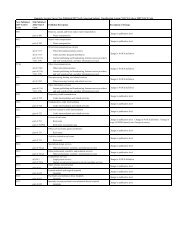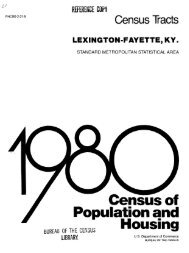1980 census of population. Characteristics of the ... - Census Bureau
1980 census of population. Characteristics of the ... - Census Bureau
1980 census of population. Characteristics of the ... - Census Bureau
Create successful ePaper yourself
Turn your PDF publications into a flip-book with our unique Google optimized e-Paper software.
Appendix B.— Definitions and Explanations <strong>of</strong> Subject <strong>Characteristics</strong><br />
GENERAL B-1<br />
HOUSEHOLD, RELATIONSHIP<br />
TO HOUSEHOLDER, FAMILY,<br />
AND GROUP QUARTERS ... B-1<br />
Household B-1<br />
Relationship to Householder . . B—<br />
Family B—<br />
SEX<br />
Group Quarters B—<br />
B-2<br />
ETHNICITY B-2<br />
AGE B-3<br />
MARITAL STATUS B-3<br />
SCHOOL ENROLLMENT B-3<br />
YEARS OF SCHOOL<br />
COMPLETED B-4<br />
PLACE OF BIRTH B-5<br />
CITIZENSHIP AND YEAR<br />
OF IMMIGRATION B-5<br />
PLACE OF BIRTH OF<br />
PARENTS B-5<br />
RESIDENCE IN 1975 B-5<br />
ABILITY TO READ AND<br />
WRITE B-5<br />
LANGUAGE SPOKEN<br />
AT HOME B-6<br />
VOCATIONAL TRAINING .... B-6<br />
FERTILITY B-6<br />
REFERENCE WEEK B-6<br />
LABOR FORCE STATUS B-7<br />
LABOR FORCE STATUS<br />
IN 1979 B-8<br />
OCCUPATION, INDUSTRY,<br />
AND CLASS OF WORKER ... B-9<br />
Occupation Classification<br />
System B-9<br />
Industry Classification<br />
System B—<br />
Class <strong>of</strong> Worker B-10<br />
INCOME IN 1979 B-11<br />
Type <strong>of</strong> Income B— 1<br />
Comparability B— 12<br />
GENERAL<br />
The <strong>1980</strong> <strong>census</strong> <strong>of</strong> Guam, American<br />
Samoa, <strong>the</strong> Nor<strong>the</strong>rn Mariana Islands and<br />
<strong>the</strong> remainder <strong>of</strong> <strong>the</strong> Trust Territory <strong>of</strong><br />
<strong>the</strong> Pacific Islands was conducted through<br />
direct interview. Enumerators visited and<br />
listed every housing unit, asking <strong>the</strong><br />
questions as worded in <strong>the</strong> questionnaire<br />
and recording <strong>the</strong> answers. Responses<br />
were determined by <strong>the</strong> questionnaire<br />
and <strong>the</strong> instructions given to <strong>the</strong> enumer-<br />
ator. The definitions and explanations<br />
given below for each subject are drawn<br />
largely from various technical and<br />
procedural materials used in <strong>the</strong> collec-<br />
tion <strong>of</strong> <strong>the</strong> data. These materials helped<br />
<strong>the</strong> <strong>census</strong> enumerators to understand<br />
fully <strong>the</strong> intent <strong>of</strong> each question, and<br />
thus to resolve problems on unusual<br />
cases in a manner consistent with this<br />
intent. Certain explanatory information<br />
to assist <strong>the</strong> user in <strong>the</strong> proper use <strong>of</strong> <strong>the</strong><br />
statistics is also included.<br />
Facsimiles <strong>of</strong> <strong>the</strong> questionnaire pages<br />
containing <strong>the</strong> <strong>population</strong> questions used<br />
to produce <strong>the</strong> data shown in this report<br />
are presented in appendix E.<br />
HOUSEHOLD, RELATIONSHIP<br />
TO HOUSEHOLDER, FAMILY,<br />
AND GROUP QUARTERS<br />
Household<br />
A household includes all <strong>the</strong> persons who<br />
occupy a housing unit. A housing unit is<br />
a house, an apartment, a group <strong>of</strong> rooms,<br />
or a single room, occupied as a separate<br />
living quarters or, if vacant, is intended<br />
for occupancy as a separate living<br />
quarters. Separate living quarters are<br />
those in which <strong>the</strong> occupants live and eat<br />
separately from any o<strong>the</strong>r persons in <strong>the</strong><br />
building and which have direct access<br />
from <strong>the</strong> outside <strong>of</strong> <strong>the</strong> building or<br />
through a common hall. The occupants<br />
may be a single family, one person living<br />
alone, two or more families living to-<br />
ge<strong>the</strong>r, or any o<strong>the</strong>r group <strong>of</strong> related or<br />
unrelated persons who share living<br />
arrangements.<br />
Because <strong>of</strong> <strong>the</strong> living arrangements<br />
among extended families in certain<br />
sections <strong>of</strong> American Samoa, additional<br />
instructions were provided to help<br />
enumerators determine whe<strong>the</strong>r a living<br />
quarters met <strong>the</strong> housing unit definition.<br />
Extended families make use <strong>of</strong> two<br />
different types <strong>of</strong> living arrangements.<br />
One type has a common kitchen surrounded<br />
by several fales (structures)<br />
where <strong>the</strong> members <strong>of</strong> <strong>the</strong> extended<br />
family sleep. The meals are prepared in<br />
<strong>the</strong> cooking fale used by all members <strong>of</strong><br />
<strong>the</strong> extended family. The family members<br />
ei<strong>the</strong>r eat <strong>the</strong>ir meals at <strong>the</strong>ir own<br />
fale or toge<strong>the</strong>r at one fale. In this<br />
arrangement, each individual fale is<br />
treated as a room within one housing<br />
unit. The o<strong>the</strong>r type <strong>of</strong> living arrangement<br />
has separate cooking facilities in<br />
each fale, but <strong>the</strong> family members share<br />
a common outdoor umu (oven). The<br />
family members pick up <strong>the</strong> cooked food<br />
from <strong>the</strong> umu and finish preparing and<br />
eating <strong>the</strong>ir meals at <strong>the</strong>ir individual fale.<br />
Since each fale has its own cooking<br />
facility, it is considered a separate<br />
housing unit. Guest houses are counted<br />
as a room in <strong>the</strong> housing unit <strong>of</strong> a matai<br />
(a chief), not as a separate housing<br />
unit as was done in 1970.<br />
The actual classification <strong>of</strong> a housing<br />
unit as a household depends on entries in<br />
question 2 and item B on <strong>the</strong> <strong>census</strong><br />
questionnaire. Item B on type <strong>of</strong> unit<br />
or quarters was filled by an enumerator<br />
or a <strong>census</strong> <strong>of</strong>fice clerk for each housing<br />
unit or group quarters.<br />
The measure "persons per household"<br />
is obtained by dividing <strong>the</strong> number <strong>of</strong><br />
persons in households by <strong>the</strong> number <strong>of</strong><br />
households (or householders).<br />
Relationship to Householder<br />
The data on relationship to householder<br />
were obtained from answers to ques-<br />
tion 2, which was asked <strong>of</strong> all persons in<br />
housing units.<br />
B-1





